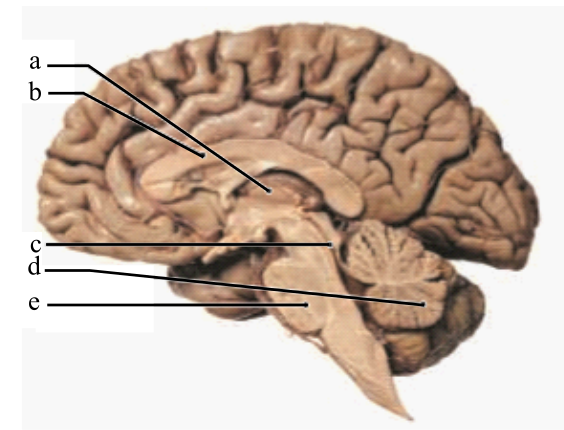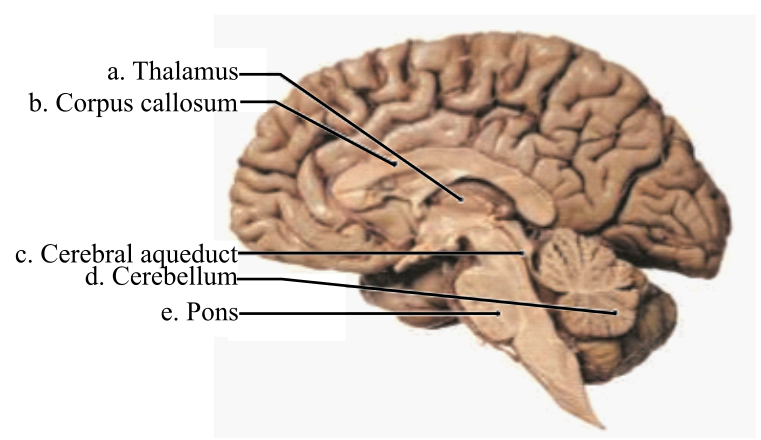
Concept explainers
To review:
Label the following terms in the given diagram of the midsagittal section of the brain: pons, corpus callosum, cerebellum, thalamus, and cerebral aqueduct.

Introduction:
The brain is the prime organ of the CNS (central nervous system). It is divided into six major regions on the basis of structure and function, which are cerebrum, cerebellum, medulla oblongata, pons, diencephalon, and mesencephalon.
Explanation of Solution
The structures of the midsagittal section of the brain are labeled as below:

Thalamus: It is a part of the diencephalon that is further divided into right and left thalamus. This region is assigned the duty to relay and process sensory information across the brain.
Corpus callosum: It is a bundle of commissural fibers that connects the two cerebral hemispheres. It functions to transfer information from one hemisphere to another. It contains the largest portion of the white matter in the brain.
Cerebral aqueduct: It is a part of the mesencephalon or midbrain. It connects the third and fourth ventricles within the diencephalon and mesencephalon respectively. It is filled with cerebrospinal fluid (CSF), which flows into the ventricles.
Cerebellum: It is a part of the hindbrain and called as the small brain. It functions to relay motor sensations and is involved in intellectual development. It also maintains the posture of the body.
Pons: It is a part of the brainstem and is located below the midbrain, above the medulla oblongata and anterior to the cerebellum. It functions to relay sensory information between the thalamus and the cerebellum. It is responsible for the maintenance of body posture, hearing, taste, touch, pain, facial expression, chewing, salivation, and secretion of tears.
Therefore, the structures of a midsagittal section of the brain are:
| a | Thalamus |
| b | Corpus callosum |
| c | Cerebral aqueduct |
| d | Cerebellum |
| e | Pons |
Want to see more full solutions like this?
- can you help? I think its B but not surearrow_forwardSkip to main content close Homework Help is Here – Start Your Trial Now! arrow_forward search SEARCH ASK Human Anatomy & Physiology (11th Edition)BUY Human Anatomy & Physiology (11th Edition) 11th Edition ISBN: 9780134580999 Author: Elaine N. Marieb, Katja N. Hoehn Publisher: PEARSON 1 The Human Body: An Orientation expand_moreChapter 1 : The Human Body: An Orientation Chapter Questions expand_moreSection: Chapter Questions Problem 1RQ: The correct sequence of levels forming the structural hierarchy is A. (a) organ, organ system,... format_list_bulletedProblem 1RQ: The correct sequence of levels forming the structural hierarchy is A. (a) organ, organ system,... See similar textbooks Bartleby Related Questions Icon Related questions Bartleby Expand Icon bartleby Concept explainers bartleby Question Draw a replication bubble with two replication forks.blue lines are DNA single strands and red lines are RNA single strands.indicate all 3' and 5’ ends on all DNA single…arrow_forwardProvide an answerarrow_forward
- Question 4 1 pts Which of the following would be most helpful for demonstrating alternative splicing for a new organism? ○ its proteome and its transcriptome only its transcriptome only its genome its proteome and its genomearrow_forwardIf the metabolic scenario stated with 100 mM of a sucrose solution, how much ATP would be made then during fermentation?arrow_forwardWhat is agricuarrow_forward
- When using the concept of "a calorie in is equal to a calorie out" how important is the quality of the calories?arrow_forwardWhat did the Cre-lox system used in the Kikuchi et al. 2010 heart regeneration experiment allow researchers to investigate? What was the purpose of the cmlc2 promoter? What is CreER and why was it used in this experiment? If constitutively active Cre was driven by the cmlc2 promoter, rather than an inducible CreER system, what color would you expect new cardiomyocytes in the regenerated area to be no matter what? Why?arrow_forwardWhat kind of organ size regulation is occurring when you graft multiple organs into a mouse and the graft weight stays the same?arrow_forward
- What is the concept "calories consumed must equal calories burned" in regrads to nutrition?arrow_forwardYou intend to insert patched dominant negative DNA into the left half of the neural tube of a chick. 1) Which side of the neural tube would you put the positive electrode to ensure that the DNA ends up on the left side? 2) What would be the internal (within the embryo) control for this experiment? 3) How can you be sure that the electroporation method itself is not impacting the embryo? 4) What would you do to ensure that the electroporation is working? How can you tell?arrow_forwardDescribe a method to document the diffusion path and gradient of Sonic Hedgehog through the chicken embryo. If modifying the protein, what is one thing you have to consider in regards to maintaining the protein’s function?arrow_forward
 Human Physiology: From Cells to Systems (MindTap ...BiologyISBN:9781285866932Author:Lauralee SherwoodPublisher:Cengage Learning
Human Physiology: From Cells to Systems (MindTap ...BiologyISBN:9781285866932Author:Lauralee SherwoodPublisher:Cengage Learning Fundamentals of Sectional Anatomy: An Imaging App...BiologyISBN:9781133960867Author:Denise L. LazoPublisher:Cengage Learning
Fundamentals of Sectional Anatomy: An Imaging App...BiologyISBN:9781133960867Author:Denise L. LazoPublisher:Cengage Learning Anatomy & PhysiologyBiologyISBN:9781938168130Author:Kelly A. Young, James A. Wise, Peter DeSaix, Dean H. Kruse, Brandon Poe, Eddie Johnson, Jody E. Johnson, Oksana Korol, J. Gordon Betts, Mark WomblePublisher:OpenStax College
Anatomy & PhysiologyBiologyISBN:9781938168130Author:Kelly A. Young, James A. Wise, Peter DeSaix, Dean H. Kruse, Brandon Poe, Eddie Johnson, Jody E. Johnson, Oksana Korol, J. Gordon Betts, Mark WomblePublisher:OpenStax College





